#dungeons and dragons tips
Text
Need to make a last minute fantasy city/town?
I got just the trick for you. Exaggerate a city you’re already familiar with. A hometown? Capital? Friend’s town? Exaggerate it with fantastical elements and maybe even inside jokes. Not too long needs to pass before you got a convincing fantasy city.
A small rural town known for its flowers? A secluded village swallowed by giant boughs of wildflowers, where masterful but painstakingly traditional druids live.
A city with terrible potholes and construction that never ends? Make it a city built upon massive caverns and canyons, repairing the results of constant dangerous dragon attacks.
Detroit? A city of thieves, that upon entering, with each passing hour you yourself become more and more thief-like.
Really do this! Exaggerate more than one element, and you get a place even more unlike with what you started from.
#quick tips#fantasy cities#worldbuilding#worldbuilding tips#worldbuilding cities#worldbuilding towns#worldbuilding villages#detroit#fantasy towns#quick fantasy tips#writing#writing tips#writing advice#D&D#D&D tips#dungeons and dragons tips#worldbuilding advice#worldbuilding advise#writing advise#this is so much fun trust me#fantasy worldbuilding#fantasy writing#last minute
1K notes
·
View notes
Text
Guys! I cracked the code! I wish I had any followers to share this magic revelation I had!
In D&D I love being a DM. I really do. With one exception.
Money.
Knowing how much a character should buy or sell something for is just way out of my grasp. For a rare item the price can be anywhere between five hundred and five THOUSAND. That’s a big difference! How am I supposed to know in between those two numbers what it should be?
I googled. And googled. And googled. Thinking *there must be a better way* and couldn’t find a single thing that made sense. Well me and two other DM friends got together and we figured it out. The magic system of pricing.
So first you take the pricing by magic item rarity in the DMG

Then you go to Xanathars and look at the Magic Item Tables to determine if the item is major or minor
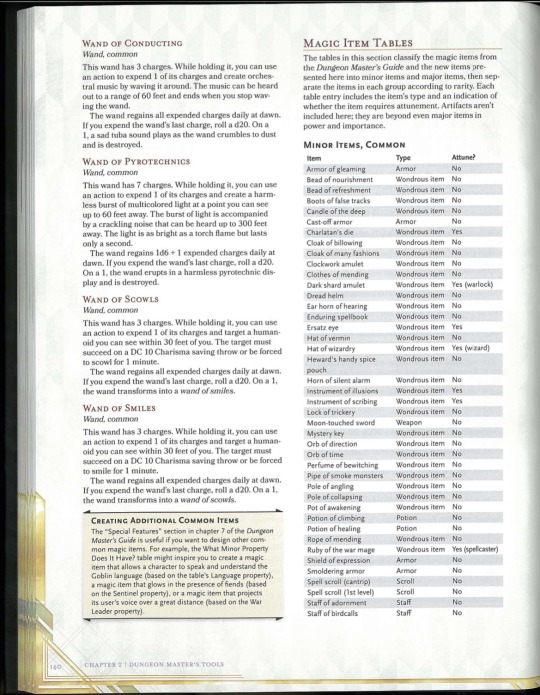
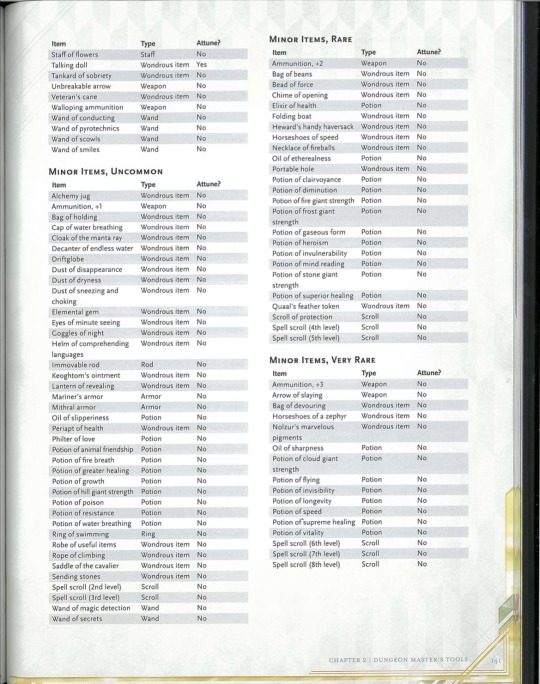
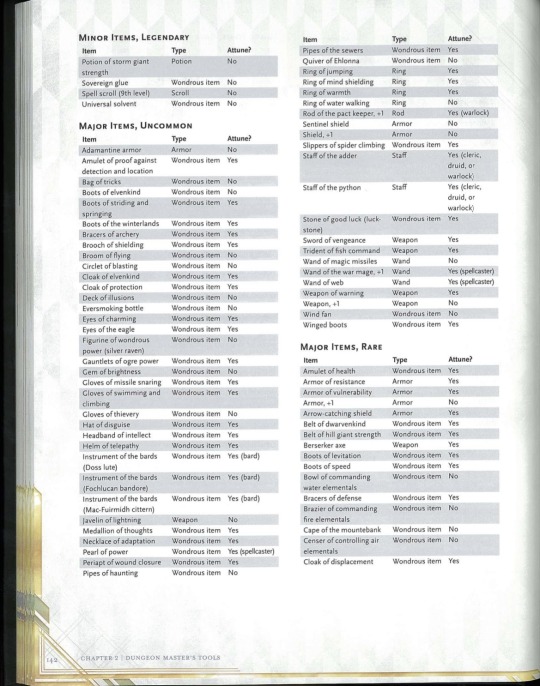
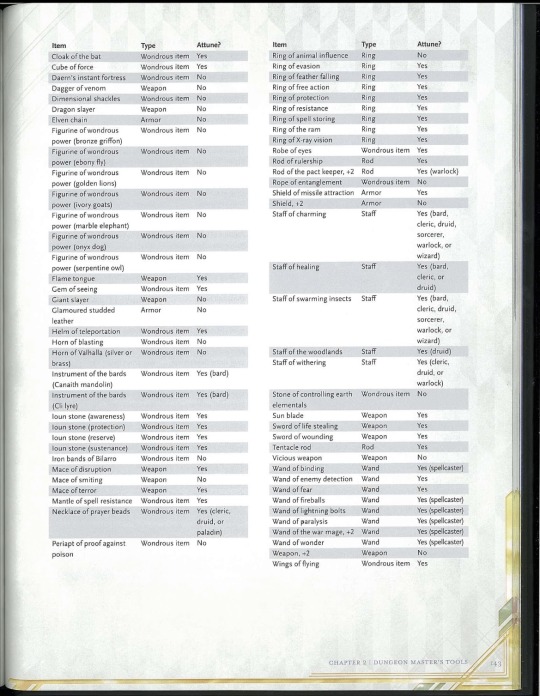
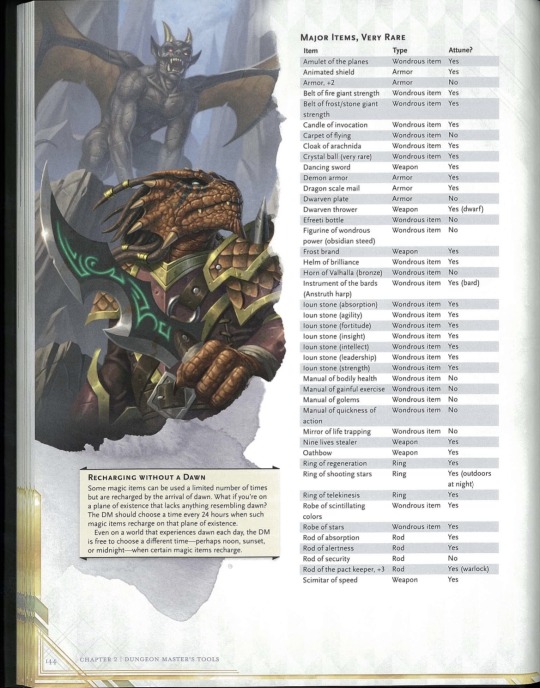
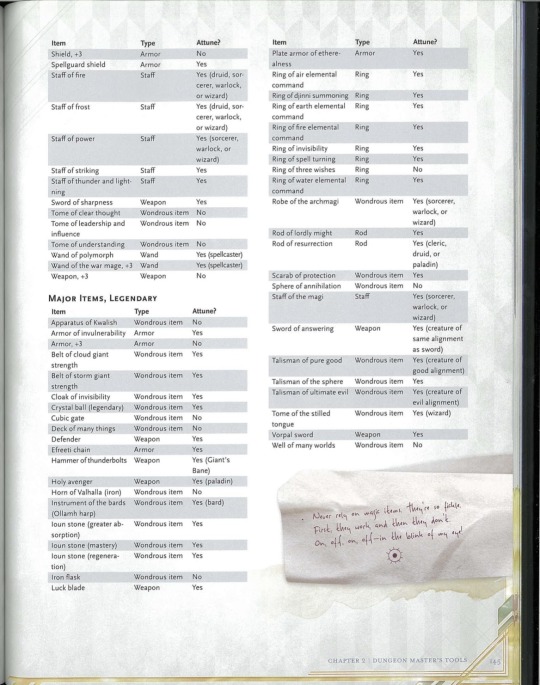
Divide the prices in the rarity into major and minor. Major the higher half and minor the lower.
So that makes
Rare Minor - 500 - 2,500
Rare Major - 2,501 - 5,000
Very Rare Minor - 5,001 - 30,000
Very Rare Major - 30,001 - 50,000
Legendary Minor - 50,000 - 300,000
Legendary Major - 300,000 - 500,000
Then
THEN
It’s all up to a persuasion roll. Because let’s face it, what’s a fantasy shopping adventure of magic items without bartering and haggling?
So you divide the amounts into roll milestones. So a persuasion roll of 0-10 you pay the highest and 20+ you pay the lowest.
Like so:
Common Items: 1d6 x 10
Uncommon Items 1d6 x 100
Rare Minor:
0-9: 2,500
10-11: 2,100
12-14: 1,700
15-17: 1,300
18-19: 900
20+ : 500
Rare Major
0-9: 5,000
10-11: 4,600
12-14: 4,200
15-17: 3,800
18-19: 3,200
20+: 2,500
Very Rare Minor
0-9: 30,000
10-11: 25,000
12-14: 20,000
15-17: 15,000
18-19: 10,000
20+ : 5,000
Very Rare Major
0-9: 50,000
10-11: 45,000
12-14: 40,000
15-17: 35,000
18-19: 30,000
20+ : 25,000
Legendary
0-9: 250,000
10-11: 200,000
12-14: 150,000
15-17: 100,000
18+ : 50,000
Legendary Major
0-9: 500,000
10-11: 450,000
12-14: 400,000
15-17: 350,000
18-19: 300,000
20+ : 250,000
Seriously someone who is followed by a lot of D&D people find this shit and spread it! It’s so much easier and makes a million times more sense then anything I ever heard of before and i wish someone else would have thought of it sooner (or if someone else did that I had found it sooner)
#dungeons and dragons#dnd#D&D#magic items#DM#dungeon master#DM tips#Dungeon master tips#dungeons and dragons tips#dnd tips#D&D tips#someone please make this famous#why hadn’t I found this earlier#holy shit#i don’t know how to tag
1K notes
·
View notes
Text
Hey all, This is my first Tumblr post ever! I'm pretty new here, but I'm hoping to share some DM techniques, tools and tips and to make some new friends as well! Feel free to send a chat request (an ask[?]) if you're interested!
With that aside, on with the post!
Better and More Meaningful Random Encounters!
Random encounters are a staple of DnD, they are expected to be there during exploration as a way to make the world feel alive, to have it have an aura of adventure and danger, to eat up party resources and put pressure on the PCs to make interesting and important choices, and also as a way for a DM to reasonably 'stall' the party with a quick and easy situation.
Usually, it ends up something like this:
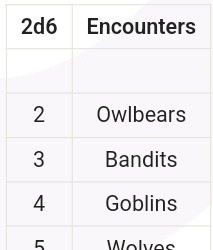
There's just one problem with most random encounter tables though, it's so easy for them to be GOSHDARN BORING! Especially for a newer DM.
Making them interesting becomes gambled improv on the DM's part if they're not used to it, and it's hard to keep track of the important factors that need to be kept in mind
Luckily, I ended up finding a great source for random encounters from 'Dungeon Masterpiece' on YouTube, and I integrated it into my own DMing. I figured that I'd share it here for any that want to work it into their own sessions as well!
After adjustment, a single table can account for multiple entire sessions of in-depth worldbuilding and fun without getting dull!
Sources:
Source 1 (Creating interesting Random Encounter Tables):
youtube
Source 2 (Making Random Encounters reflect your Worldbuilding):
youtube
There's 4 major methods we can use to improve the Random Encounter table
1. Make the table a straight 1dx roll.
2. Adding 'depth'.
3. Adding meaningful encounters.
4. Prerolling and/or Multirolling.
You can also check out the "Where to Start?" section for some direction to make getting it down and prepped all easy peasy!
1. Straight Roll:
Its enticing to go for 2d6 or the such in order to add non-linearity to the rolls, but these sorts of adjustments only end up making one or two encounters extremely likely and leave all others in the dust, it often ends up defeating it's own purpose of interesting randomness.
In the previous example, it was extremely likely to only get Wolves, Barbarians, Orcs, or Spiders, from a table of 12! A straight roll would serve us much better. The rare rolls are already rare enough as is!
Simply enough, adjusting the original example by replacing the 2d6 with 1d12, it'd become something more like this:
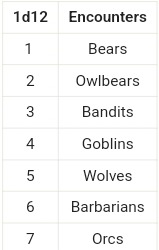
#2. Adding Depth:
We can add more columns in the encounter tables. These columns will represent different aspects about the encounters that we can roll on separately!
Usually it can be difficult as a DM to naturally come up with motives for the encounters, showcase the worldbuilding and have it all come together.
This setup can give you a solid guideline on how the creatures/people think (if any), and also sets up the overall area so that you get an idea of what events tend to occur there as a result of its occupants.
We want to add 3 more columns to the tables to convey different aspects of the encounter. Fill in these new columns corresponding to the expectations of each encounter.
We'll roll each of these and combine them, then we'll interpret them to make a robust, in-depth random encounter with truly unexpected results!
I recommend rolling alot of complete encounters at once and interpreting the context to the vast general area the party is travelling in.
i. Behaviour: How the creatures act. Are they friendly, scared, aggressive, curious, mischievous?
ii. Complication: Something behind the scenes in the encounter. Do they have sick young? Broken equipment? Are they starving?
iii. Significant Impact: This is a tick box, and will only be present under ONE of the rows. It will be rolled like the other columns, but ONLY once. It signifies which encounter is the Significant Encounter
The Significant Encounter will have its encounter's presence prominent amongst all the other random encounters in the area. There could be burn marks and carcasses from a rampant dragon, or a goblin raid leaving tracks moving through the area. Which is the most impactful of the different encounters?
Adding this to our previous example would expand it to:
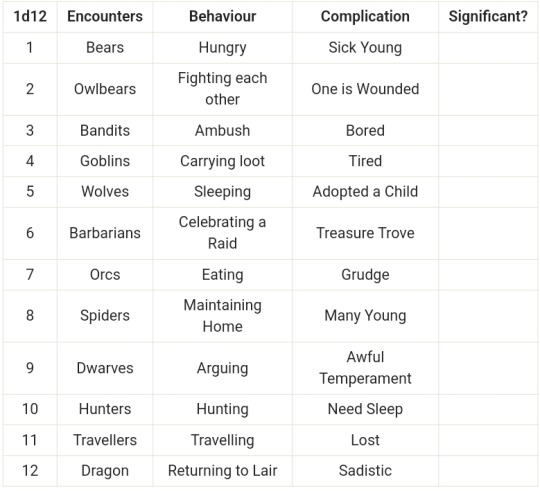
Rolling this would give us things like:
Significant encounter: Owlbears

Note that the significant impact shows that the Owlbears are a massive problem in the area. Perhaps the Owlbears are agitated for an unknown reason, and are unnecessarily aggressive.
The significance of Owlbears gives us context to the second one as well! Perhaps the hunters raided an Owlbear den, and adopted an Owlbear cub from there as well.
There could be uneaten carcasses, ravaged trees, less wildlife, etc around these parts.
Note how much sheer CONTEXT these columns add to our encounters. It's invaluable!
3. Adding Meaningful Encounters
Usually random encounters tend to be rather mundane and very one-note.
There's usually some general wildlife and monsters, different disparate factions without any rhyme or reason, and maybe a general non-combat encounter or two, but these don't really tell us about the area or its surroundings at all by themselves.
Instead, we can add in wildlife and monster encounters specific to the biome, non-combat encounters, and encounters of nearby factions and/or settlements to the table, and we can even add environmental encounters in there as well.
Note that we're not tied down to 12 encounters, and can expand it ad infinitum according to our need of diversity in our encounters.
Just add in specification and connection, and suddenly the dominos all fall into place.
Lastly, we'll also be adding in 'DOUBLE TIME' which will let us roll on everything twice, and make it so it's a double encounter!
Thus, the table can instead be adjusted to:
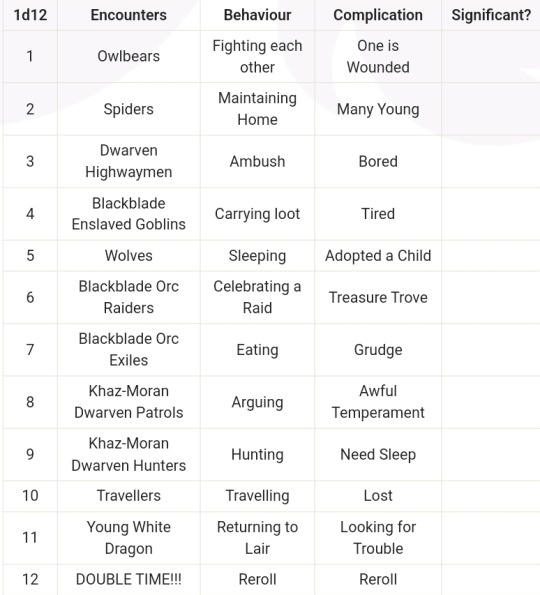
Note how each and everything has its relation in one way or another, but through the sheer variance, they remain truly random and novel.
4. Prerolling and/or Multirolling
Lastly and this is just something that I do, but that I found gamechanging. Be sure to pre-roll 5-7 encounters for each session, for the general area the players are going to be headed in.
Note that you don't need to really prep anything at all, just interpret all of them on a surface level as a buffer.
Also note that you don't need to use all of them if they're not needed. The foreshadowing and signs are worldbuilding and having secrets that the players don't unravel is just as useful as the ones that they do, perhaps even moreso. It adds depth and detail beyond the scope of what the party will encounter
It simply let's you get an idea of the connections between encounters, allows for foreshadowing, and acts as a deterrent to getting caught off guard.
Even if you roll mid-session, I recommend calling for a 5 minute break, rolling 5-7 encounters at the same time and interpreting them and their connections before resuming the session.
It WILL make a difference, trust me
Where to start?
It can be difficult getting inspiration or direction to get started in creating these random encounters, and sometimes you don't want to go through the hassle of thinking them up from nothing
For some great conceptual headstarts and examples for these tables, you can check out 'Worlds Without Number' and it's:
- Page 205 (Great general templates for encounters differentiated by broad creature types such as Beasts and Monsters, Sapient Monsters, and Humans)
- Pages 206-219 (For inspired locations to occasionally run rare encounters or groups of encounters in. This works best with flexible/discovered worldbuilding given the significance of some of these, and you also want to add these in sparingly to keep them significant)
- Pages 246-247 (These pages have great templates for the kinds of encounters and situation to be included in the tables, and it can be expanded vastly, and certain options can be selectively and repeatedly chosen to meet our needs. Mood works well as a complication.)
There might be other pages that are useful as well for these sorts of random encounters in the wilderness that I haven't come across yet. If so, give them a shout out and I'll be sure to add them in. It's worth checking it out in its entirety for some great tips!
Conclusion
Again, credit goes to Dungeon Masterpiece and Worlds Without Number for excellent adjustments. This has been quite long, but I hope you stuck around till the end.
Many a session have been made easy but complex ever since this was introduced and I hope that this helps you out as much as it helped me in my prep and improv!
Feel free to give any advice in formatting on Tumblr, or any feedback on the post itself. It really means a lot to me, thanks!
#dm tools#dungeons and dragons tips#dungeon master tips#dm advice#dm tips#ttrpg#dnd#Youtube#dnd resources#gm tips
58 notes
·
View notes
Text
i know that i have like 5 followers and i also do not have a single goddamn clue as to how tumblr works but i want to share my interests with people and possibly help other people expand on and find new interests as well :)
so… i fucking love dnd. the whole everything, character-creating, the rules and structures behind rolls and making a balanced character/campaign, the cool dice i now have an excuse to buy, but MOST OF ALL- writing mini-campaigns for my friends (which usually ends in me committing a little bit of psychological ware-fare).
im really rather new to this (just finished writing my second mini-campaign and currently three sessions in to a long-running campaign i have a character in) but i can already see how far ive improved from my first campaign to now and how much further i can go in the future with potentially longer campaigns, and im 100% willing to share anything ive learnt or any tips i have regarding campaign-writing. i also wouldnt mind some more experienced players/game masters to provide some tips or important info theyve learnt throughout their time playing/dm-ing that could help me make my campaigns as fun and engaging for my friends as possible so if anyone has been itching for a way to share their knowledge- go WILD!! the more advice the better :)
that is all :D

#dnd#dnd campaign#dnd advice#dnd writing#writing advice#dungeons and dragons#dnd campaign writing#dungeons and dragons tips#dm advice
22 notes
·
View notes
Text
I'm bored so fuck it!
Here's your new guide to the DnD alignment system!
Now you may be thinking, "But HeeHoo! Isn't it straight forward as it is?"
And to that, random internet stranger, I must unfortunately say no. It is not. God I wish it was as straight forward as many people tend to try to make it out to be.
And the problem here is one very common misconception: that the Good, Neutral, Evil scale is about actions and doing the right or wrong thing.
This is incorrect. As much as we would love to judge characters solely on their actions (as we often do with people in real life), you don't typically have that choice in a proper game. You have to make hard, split second decisions, and sometime you're going to do the wrong thing. Plus, you can't predict that ahead of time when you're making the character.
The DnD alignment system, therefore, is actually about intention and motive. Good aligned characters often have good intentions. They want to help people in some way, shape or form. They WANT to do good (however skewed their perception of good may be).
A lawful good paladin, for example, might slaughter a den of goblins with the intention of protecting a nearby town. Their intent is good. However, they've also now slaughtered countless sentient creatures, so how "good" that action really was is...questionable.
On the other hand, an evil aligned character is a character that intends to, well, do evil. Just because that paladin went on a murderous rampage against this cave of goblins that was, for all intents and purposes, minding their own business, that doesn't make them evil. It would have been an evil aligned act if, instead of attempting to guarantee the safety of a nearby village, they had done it just to kill. Just to murder something or just because they hate goblins as a whole.
An evil aligned character wants to hurt people for the sake of hurting people. This is...the good majority of murder hobo players. Killing just because you can, just to cause as much destruction as possible. Screwing people over for the hell of it or for revenge or other similar motives.
And then that leaves us with neutral players. Neutral characters are characters that aren't here because they believe it's the right thing to do, but they also aren't here because they believe it will allow them to cause damage. They're here simply because it's what's convenient for them for now. It's what works.
Lawful neutral players will follow the law (or a strict moral code), not because they believe it's right, but because the opposite is much less convenient. Chaotic neutral players reject laws and moral codes because being spontaneous and unpredictable is what's worked out so far for them. True neutral players don't care one way or another and will likely simply act according to what's convenient for them at the time.
The lawful to chaotic scale is much more direct and clear. Lawful players will adhere to either a set of laws or rules, or some other moral code (though lawful evils and neutrals may have a tendency to only follow the letter if the law, not the spirit, like a lawyer or fae).
Chaotic players actively reject these boundaries and laws and often operate beyond them or go out of their way to break them. Jaywalking because fuck the crosswalks they're stupid! Stealing because capitalism sucks and this is so much easier/enjoyable!
Neutrals on this scale will jaywalk because it's easier to do that than walk all the way to the end of the street for a crosswalk, or steal because you can't afford to spend the money and really need the items. They'll volunteer if there's something in it for them, do the right thing if there's a decent enough reward for it to be worth their time.
So there you have it!
The DnD alignment chart isn't about whether or not you would always do the right or wrong thing, but rather about whether or not you would try to do the right or wrong thing, or if it doesn't really matter to you at all.
You can't align characters based on their actions, because their alignment influences why they're taking those actions in the first place.
What does your character think they're doing? It doesn't matter how questionable their methods are, a character is still good so long as their motives are.
In conclusion, Kyubey is a Lawful Good, good night everybody <3
#dnd#dungeons and dragons#dnd tips#dungeons and dragons tips#alignment chart#alignment#pmmm#slime speaks
18 notes
·
View notes
Text
HEY DUNGEON MASTERS!!
What is a funky quirky thing you do for your campaign? (Totally not asking cuz im running low on ideas)...
ILL GO FIRST:
The places in my campaign are named after biology terms... (Ex. Palisade, Stomata, Mesophyll, Sepals. Pistil, Antheridia)
Most of my homebrew items are my cooking experiments IRL!!!! (Ex. Mint Stew, mushroom tarts, custard pie) AND THEY GIVE RANDOM POWER UPS CUZ I SAID SO. (Custard Pies can heal cuz yummy and my lemon bars give night vision) (The lemon bar thing was inspired by quincy's tavern on tiktok w/ his Lumi Bars)!!
My NPCs are named after songs/artists. (My players caught on to this one hahaha) I named one of my NPC September cuz I was listening to September the day before.
#dnd#dnd5e#dungeons and dragons#dungeon master#dungeon masters questions#dungeon masters#dnd help#dnd tips#dungeons and dragons tips#world building#biology#questions#tips and tricks#i need more spice in my campaign#dnd campaign
38 notes
·
View notes
Text

#What to do if No One Wants to Come on an Adventure With You Except a Stray Dog#tips#trips#advice#life hacks#helpful hints#dog#dogs#dogs are the best#Dungeons & Dragons#D&D#Dungeons and Dragons
3K notes
·
View notes
Text

Dm Tip: Playing the Villain/ Guidelines for "Evil" Campaigns
I've never liked the idea of running an evil game, despite how often I've had people in my inbox asking how I'd go about it. I'm all about that zero-to-hero heroic fantasy not only because I'm a goodie twoshoes IRL but because the narrative-gameplay premise that d&d is built around falls apart if the party is a bunch of killhappy murder hobos. Not only would I get bored narrating such a game and indulging the sort of players who demands the freedom to kill and torture at will (I've had those before and they don't get invited back to my table), but the whole conceit of a party falls through when the obviously villainous player characters face their first real decision point and attempt to kill eachother because cooperation is a thing that goodguys do.
Then I realized I was going about it all wrong.
The problem was I had started out playing d&d with assholes, those "murder and torture" clowns who wanted to play grand-theft-auto in the worlds I'd created and ignore the story in favour of seeing how much unchallenged chaos they could create. They set my expectations for what an evil campaign was, and I spent the rest of my time developing as a dungeonmaster thinking " I Don't want any part of that"
But what would an evil campaign look like for my playgroup of emotionally healthy friends who understand character nuance? What would I need to change about the fundamental conceit of d&d adventures to refocus the game on the badguys while still following a similar enough narrative-gameplay premise to a hero game? How do we make that sort of game relatable? What sort of power/play fantasy can we indulge in without going off the deepend?
TLDR: In an evil campaign your players aren't playing the villains, they're the MINIONS, they're mooks, henchmen, goons, lackeys. They're the disposable underlings of uncaring overseers who have nothing but ill intent towards them and the world at large.
Where as in a hero game the party is given the freedom to challenge and overthrow corrupt systems, in an evil game the party is suck as part of that corrupt system, forced to bend and compromise and sacrifice in order to survive. The fantasy is one of escaping that corrupt system, of biding your time just long enough to find an opening, find the right leverage, then tossing a molitov behind you on the way out.
Fundamentally it's the fantasy of escaping a shitty job by bringing the whole company down and punching your asshole boss in the face for good measure.
Below the cut I'm going to get into more nuance about how to build these kinds of narratives, also feel free to check out my evil party tag for campaigns and adventures that fit with the theme.
Designing a campaign made to be played from the perspective of the badguys requires you to take a different angle on quest and narrative design. It’s not so simple as swapping out the traditionally good team for the traditionally bad team and vis versa, having your party cut through a dungeon filled with against angel worshiping holyfolk in place of demon worshipping cultists etc.
Instead, the primary villain of the first arc of the campaign should be your party’s boss. Not their direct overseer mind you, more CEO compared to the middle managers your party will be dealing with for the first leg of their journey. We should know a bit about that boss villain’s goals and a few hints at their motivation, enough for the party to understand that their actions are directly contributing to that inevitable doom.
“Gee, everyone knows lord Heldred swore revenge after being banished from the king’s council for dabbling in dark magic. I don’t know WHY he has us searching for these buried ancient tablets, but I bet it’s not good”
Next, you need a manager, someone who’s a part of the evil organization that the party directly interfaces with. The manager should have something over the party, whether it be threats of force, blackmail, economic dependency… anything that keeps the antiheroes on the manager’s leash. Whether you make your manager an obvious asshole or manipulative charmer, its important to maintain this power imbalance: The party arn’t going to be rewarded when the boss-villain’s plan goes off, the manager is, but the manager’s usefulness to the boss-villain is contingent on the work they’re getting the party to do. This tension puts us on a collison course to our first big narrative beat: do the party get tired of the manager’s abuse and run away? Do they kill the manager and get the attention of the upper ranks of the villainous organization? Do they work really hard at their jobs despite the obvious warning signs and outlive their usefulness? Do they upstage their manager and end up getting promoted, becoming rivals for the boss-villain’s favor?
Building this tension up and then seeing how it breaks makes for a great first arc, as it lets your party determine among themselves when enough is enough, and set their goals for what bettering the situation looks like.
As for designing those adventures, you’ll doubtlessly realize that since the party arn’t playing heroes you’ll need to change how the setup, conflict, and payoff work. They’re still protagonists, we want them to succeed after all, but we want to hammer home that they’re doing bad things without expecting them to jump directly to warcrimes.
Up to no good: The basic building block of any evil campaign, our party need to do something skullduggerous without alerting the authorities. This of course is going to be easier said than done, especially when the task spins out of control or proves far more daunting than first expected. The best the party can hope for is to make a distraction and then escape in the chaos, but it will very likely end with them being pursued in some manner (bounties, hunters, vengeful npcs and the like). Use this setup early in a campaign so you have an external force gunning for your party during the remainder of their adventures.
Dog eat dog: It’s sort of cheating to excuse your party’s villainous actions by having them go up against another villain who happens to be worse than they are. The trick is that we’re not going after this secondary group of outlaws because they’re bad, we’re doing it because they’ve either got something the boss wants, or they’re edging in on the boss’s turf. This sort of plotline sees the party disrupting or taking advantage of a rival’s operation, then taking over that operation and risking becoming just as villainous as that rival happened to be. This can also be combined with an “Up to no good” plot where both groups of miscreants need to step carefully without alerting an outside threat.
The lesser evil: This kind of plot sees your party sent out to deal with an antagonistic force that’s a threat not only to the boss’s plans but to everyone in general. In doing so they might end up fighting alongside some heroes, or accidentally doing good in the long run. This not only gives your party a taste of heroism, but gives them something in their back pocket that could be used to challenge the boss-villain in the future.
The double cross: In order to get what they want, the party need to “play along” with a traditional heroic narrative long enough to get their goal and then ditch. You have them play along specifically so they can get a taste of what life would be like if they weren't bastards, as well as to make friends with the NPCs inevitably going to betray. This is to make it hurt when you have the manager yank the leash and force the party to decide between finishing the job , or risk striking out on their own and playing hero in the short term while having just made a long term enemy. This is sort of plot is best used an adventure or two into the campaign, as the party will have already committed some villainous deeds that one good act can’t blot out.
Next, lets talk about the sort of scenarios you should be looking to avoid when writing an evil campaign:
Around the time I started playing d&d there was this trend of obtusely binary morality systems in videogames which claimed to offer choice but really only existed to let the player chose between the power fantasy of being traditionally virtuous or the power fantasy of being an edgy rebel. Early examples included:
Do you want to steal food from disaster victims? in Infamous
Do you as a space cop assault a reporter who’s being kind of annoying to you? in Mass Effect
Do you blow up an entire town of innocent people for the lols? in Fallout (no seriously check out hbomberguy’s teardowm on fallout 3’s morality system and how critics at the time ate it up)
I think these games, along with the generational backwash of 90s “edge” and 00s “grit” coloured a lot of people's expectations ( including mine) about what a "villain as protagonist" sort of narrative might look like. They're childish exaggerations, devoid of substance, made even worse by how blithely their narratives treat them.
Burn down an inn full of people is not a good quest objective for an evil party, because it forces the characters to reach cartoonish levels of villainy which dissociates them from their players. Force all the villagers into the inn so we can lock them inside and do our job uninterrupted lets the party be bad, but in a way that the players can see the reason behind it and stay synced up with their characters. The latter option also provides a great setup for when the party's actually monstrous overseer sets the inn on fire to get rid of any witnesses after the job is done. Now the party (and their players) are faced with a moral quandary, will they let themselves be accessories to a massacre or risk incurring their manager's wrath? Rather than jumping face first into cackling cruelty, these sorts of quandaries have them dance along the knife's edge between grim practicality and dangerous uncertainly; It brings the player and character closer together.
Finally, lets talk about ending the villain arc:
I don't think you can play a whole evil campaign. Both because the escalation required is narratively unsustainable, but also because the most interesting aspect of playing badguys is the breaking point. Just like heroes inevitably having doubts about whether or not they're doing the right thing, there's only so long that a group of antiheroes can go along KNOWING they're doing the wrong thing before they put their feet down and say "I'm out". I think you plan a evil campaign up until a specific "there's no coming back from this" storybeat, IE letting the Inn burn... whether or not the party allows it to happen, it's the lowest point the narrative will allow them to reach before they either fight back or allow themselves to be subsumed. If they rebel, you play out the rest of the arc dismantling the machine they helped to build, taking joy in its righteous destruction. If they keep going along, show them what they get for being cogs: inevitably betrayed, sacrificed, or used as canon fodder when the real heroes step in to do their jobs for them.
Art
#dm tip#dm tips#writing advice#evil party#drafting the adventure#dnd#d&d#dungeons and dragons#blades in the dark#ttprg#pathfinder
407 notes
·
View notes
Text
Every time I look at how to create a world for a campaign or just plan a campaign on the internet you usually get : start small with the town and maybe the few places around, you don't need to know everything about the world to start the campaign.
However what if your players want to create characters that come from beyond that place. You'll need to tell them what the world is like, what others kingdoms and lands there are and what is happening in there for them to be able to put their character in there and know what is going on so they have some guidelines about the world's alliances etc ?
How do you do ? (Also if I'm looking at it wrong please tell me I am but an aspiring DM)
394 notes
·
View notes
Text
DM/GM Mistakes I made my first time
And how to not make them
I started my first ran campaign as a homebrew so trust when I say I have made grand mistakes. I myself am still new to the game, and finding new things every day, despites starting about three years ago.
So here’s some of them, and how not to do them
Giving players OP (magical) items
I still regret this one in my running campaign. I tragically gave my players a handful of OP items out of fear of not pleasing them with the loot prepared. I didn’t think of the implications real well, and kept doing it after seeing the glee on my players faces after the first one.
How to avoid...
Never give powerful items on a whim
Think of the implications, whether your players are assholes or not, they will metagame, minmax, and exploit. So plan for it. Pretend that they will, and plan for it.
Start small, and experiment with your players & loot. Tiny little things will do just as well most of the time, and big items are better for late game players.
Sidetracking Side Quests
Players try to look at everything as a puzzle or challenge. Often times they manage to find fake red herrings in the norm, or chase after wild geese you didn’t even know existed. Sometimes that goose is a side quest you intended to be small, and now for a second session you are watching your players chase it down.
How to avoid...
Have all or most of your side-quest tie into the main quests, so even if they get super sidetracked it will eventually bring them back into, or build on the main storyline, potentially enriching your worldbuilding & campaign.
If a quests seems too off putting for the world or storyline ditch or change it.
Don’t make the side quests more enticing than the main storyline, otherwise players will believe that it is the main storyline.
Too many PC's pets
Players will try to adopt anything and everything whether or not it's practical. Owl Bears, Displacer Beats, Local mysterious NPC. Soon enough my party had so many I couldn't keep track, and dreaded the introduction of any other animal.
Fight your PCs. If you think they shouldn't have it or be able to care for it don't let them.
Keep the pets weak and flimsy. Makes for dramatic emotional roleplay moments when they perish, and allows you to control the numbers.
Force your players to care for them so the next six pets are seen as extra resource consumers and responsibilities.
#dungeon master#dungeons and dragons tips#d&d#dnd#dungeons and dragons#ttrpg#rpg#game master#dnd advice
13 notes
·
View notes
Text
Just a friendly reminder for DMs: Many brands of wrapping paper has a 1x1in grid on the back, the perfect size for d&d maps, and all the holiday paper is currently on sale
956 notes
·
View notes
Text
Note-taking Advice Request!
I've been DMing for a few years now, but there's still one thing that eludes me. How do you take notes while DMing, without gimping out in other aspects during the game? (particularly for a homebrew world)
I find myself occupied by presentation, improvisation and ensuring that I'm carefully sprinkling in all the different aspects of the worldbuilding that add depth to my game in order to show it naturally.
I usually just end up trying to remember everything in a session instead of noting it down as its happening, because it ends up taking me 'out of the zone'.
What can end up happening is that I forget specific 'niche' aspects of the game that happen within those 2-4 hours
Anyone else had this problem? What did you do to deal with it? Thanks in advance
8 notes
·
View notes
Text
IF YOU ARE ONE OF THE PEOPLE I AM DM-ING FOR, KEEP SCROLLING NOW!!!! BIG BIG SPOILERS!!!!! IM ASKING FOR ADVICE FOR CAMPAIGN WRITING!!!
so yesterday i was tasked with writing a dnd one-shot for this weekend as a little halloween celebration, which is all well and good because i love writing campaigns and i adore dm-ing. the only problem is apparently i also love making things difficult for myself.
my main idea circles around being able to create some kind of ‘time loop’. like, they live a day/a few hours in-game and then it repeats over and over again whilst the players build their knowledge and try to figure out whats going on. currently i am unsure how to make this possible and what the ending should be (if they break out and why) so any advice/ideas they would be greatly appreciated!! (this is rather time-sensitive as i have to have it finished by saturday)
that is all!! thank you so much!!
#dnd campaign writing#dnd advice#dnd campaign#dnd#dnd5e#dming is hard#dming#dungeons and dragons tips#dungeons and dragons#campaign writing dnd
1 note
·
View note
Text
This is I think, my best prep tip as a DM:
When the players are about to visit a new town, pre-generate several NPCs who fit the demographics of the town, but don't give them jobs. Your town is Mostly human, with a number of halflings and gnomes? Make a list that's mostly humans with some halflings and gnomes mixed in, with names that match the vibe you're going for and maybe the barest description + a quirk of some sort.
So the list would look something like this:
Ophelia Bracegurdle, older Halfling woman who laughs a lot
Norabecka Johnson, a young human woman who seems tired
Geraldofinio Babblecock Nimsy, gnome gentleman who takes pains to maintain a fabulous mustache
Etc.
Then, when the players are like, "Can I go to the blacksmith?" You look at your list of NPCs and the one at the top is Ophelia Bracegurdle. She's your blacksmith now. Then they want to go to the tavern, where Norabecka is the innkeeper and Geraldofinio is a patron having a drink at the bar. He's using a straw so he doesn't mess up his mustache.
If they had gone to the inn first, Ophelia would have been the innkeeper with Norabecka as the patron, and then Geraldofinio should have been a blacksmith with some sort of mustache guard to keep the sparks off.
Making the list ahead of time doesn't take much time, and you can often re-use the people you never got to at the next town.
Your world will seem vibrant and interesting and like you have everything planned out.
Have fun!
3K notes
·
View notes
Text
if you are a dungeon master (or even a fantasy author/worldbuilder of any kind) and you don’t know about donjon let me make your life a million times easier
want to make a fantasy calendar with your own year-lengths, weeks, months, and lunar cycles? https://donjon.bin.sh/fantasy/calendar/
need to come up with some medieval town demographics? https://donjon.bin.sh/fantasy/demographics/
want to make a map and layout of a city/town? https://donjon.bin.sh/fantasy/town/
want a fleshed-out tavern complete with menu, innkeeper, patrons, rumors, and secrets? https://donjon.bin.sh/fantasy/inn/
leading your players through a dungeon and want to customize the size, treasure, layout, theme, etc? https://donjon.bin.sh/5e/dungeon/
tired of creating lists of magic items for different shops to sell, or hoards to be looted? https://donjon.bin.sh/5e/magic/shop.html and https://donjon.bin.sh/d20/treasure/
even a customizable initiative tracker! https://donjon.bin.sh/d20/initiative/
and that’s only scratching the surface! I really recommend all dms check this out. oh, and it’s completely free!
#donjon#dm#dungeons and dragons#d&d#gm#worldbuilding#cr#dm tips#dm advice#ttrpg#game master#dungeon master
433 notes
·
View notes
Text
Fun things to do as a DM to add a bit of spice to the game:
Sometimes giving beasts (like bears) barbarian rage
Starting the campaign by having your players wake up in a tavern
Said tavern is suspiciously empty of people
The town the tavern is in is also devoid of any other living creature
The shadows in the windows move
Making a red dragon a cowardly businessman
A colony of gnomes that only speak Gnomish
Putting in a puzzle you found online for children
Putting in the Monty hall problem as a puzzle
The real BBEG is actually just the accountant for the supposed BBEG (the party finds this out after killing the supposed BBEG, who was working part time at a tavern as a janitor)
I am Alpharius
Character that only speaks in rhymes and riddles except for every 7th sentence
Mega swarm of rats
Making the orcs your players were sent to fight different than they imagine (they expected barbaric melee and savagery, the orcs are all actually high class and good mannered wizards with high intelligence)
Doing the opposite with high elves is even funnier
Take inspiration from games
Make Skeletor an NPC. Not the BBEG, though he’s desperately trying to be evil.
Put a NPC wizard in named John Moses who has a staff of snakes, and the only spells he knows are insect plague, control water, contagion, and create food and water, all of which is always cast at max level, see how your players react
Golem trebuchet
Let longswords count as finesse weapons
The BBEG has a berret .50 caliber
Give important enemies death saving throws
And the lord said, plant a claymore at every entrance so they can’t escape
#wizardposting#wizard#artificer#wizard posting#gnome#gnome post#wizard tumblr#dnd#d&d#dungeons and dragons#wizardblr#wizardcore#wizard shit#wizards#dnd tips
131 notes
·
View notes